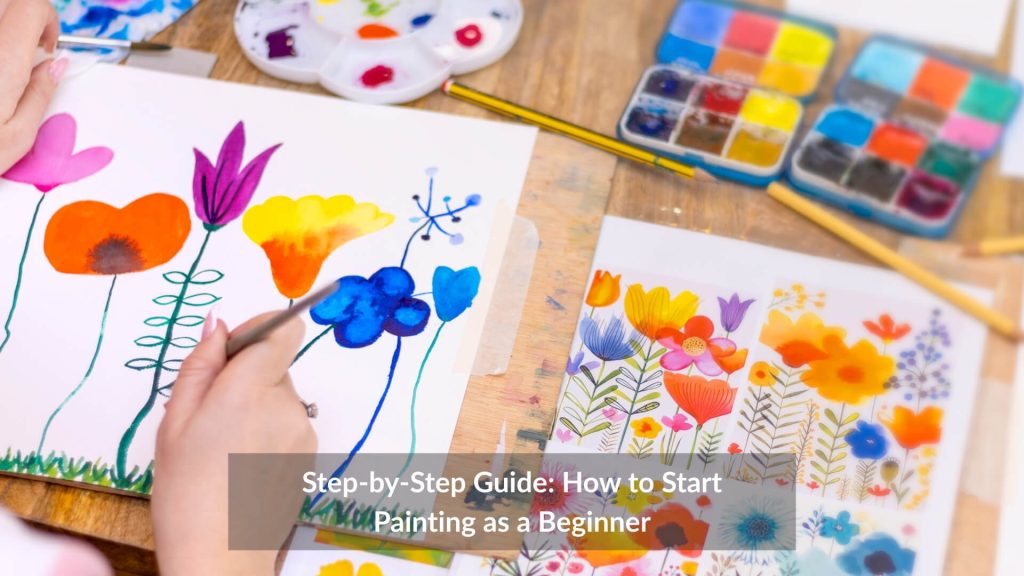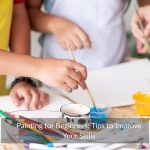
Painting is one of the most rewarding and expressive art forms in human history. From cave walls to modern digital canvases, it has always been a way for people to tell stories, express emotions, and capture beauty. But if you are a complete beginner, starting your painting journey might feel overwhelming.
Don’t worry! This guide will walk you through step by step – from understanding the basics to building confidence and creating your first masterpiece.
Step 1: Understanding Painting as an Art
What is Painting?
Painting is the practice of applying pigment (color) to a surface using tools like brushes, knives, or even fingers. It’s not only about creating something visually pleasing but also about self-expression.
Why Start Painting?
- A way to express creativity and emotions.
- Great for stress relief and mindfulness.
- Can grow from a hobby to a professional skill.
Step 2: Choosing Your Painting Medium
One of the first decisions as a beginner is picking the right medium. Each has its own charm, challenges, and style.
Oil Painting
- Rich, long-lasting, and allows blending.
- Best for realism but takes time to dry.
Watercolor Painting
- Soft, transparent, and fluid.
- Great for landscapes and illustrations.
Acrylic Painting
- Fast-drying, versatile, and beginner-friendly.
- Works on canvas, wood, glass, and fabric.
Gouache Painting
- Similar to watercolor but opaque.
- Popular for poster art and design.
Digital Painting
- Done using tablets/software like Procreate or Photoshop.
- Allows unlimited experimentation and undo options.
Tip for Beginners: Start with acrylics or watercolors. They’re affordable and easier to control than oils.
Step 3: Collecting Essential Painting Supplies
Before you dive in, make sure you have the right materials. You don’t need everything at once – just the basics.
Basic Supplies for Beginners
- Surface: Canvas, paper, or wood panel.
- Paints: Acrylics or watercolors to start.
- Brushes: Round, flat, and detail brushes in small sizes.
- Palette: For mixing colors.
- Easel: Optional but helpful for posture.
- Water jar or medium: For cleaning brushes or diluting paint.
- Rags or paper towels: To wipe excess paint.
Pro Tip
Avoid buying the cheapest supplies. Instead, go for mid-range quality to get a smoother painting experience.
Step 4: Learning the Basics of Drawing
Before painting, you should understand drawing fundamentals. A good sketch helps you structure your painting.
Why Drawing Matters for Painters
- Improves hand control.
- Helps with proportions and perspective.
- Makes painting less intimidating.
Beginner Drawing Exercises
- Practice shapes (circle, square, triangle).
- Sketch simple objects (fruit, cups, bottles).
- Learn shading using pencils before moving to paints.
Step 5: Mastering Color Theory
Color is at the heart of painting. Knowing how colors work together will take your art to the next level.
Primary Colors
Red, Blue, Yellow – all other colors come from these.
Secondary Colors
Orange, Green, Purple – made by mixing two primaries.
Warm vs Cool Colors
- Warm: Red, Orange, Yellow (energy, warmth).
- Cool: Blue, Green, Purple (calm, depth).
Techniques to Learn
- Color Mixing: Start with primaries and mix.
- Value: Learn light vs dark tones.
- Complementary Colors: Opposites on the color wheel (great for contrast).
Exercise: Create a color wheel yourself with paints.
Step 6: Practicing Basic Painting Techniques
Now it’s time to hold that brush and start practicing.
Basic Brush Techniques
- Flat Wash: A smooth layer of one color.
- Dry Brush: Minimal paint for texture.
- Blending: Mixing two colors smoothly.
- Stippling: Dots to create texture or shading.
- Glazing: Transparent color layers over dry paint.
Surface Techniques
- Canvas priming with gesso.
- Layering light to dark (for oils/acrylics).
- Wet-on-wet vs wet-on-dry (for watercolors).
Step 7: Starting with Simple Subjects
Don’t jump into painting portraits or complex scenes right away. Start small.
Beginner-Friendly Painting Ideas
- Sunset or sunrise.
- A single flower or vase.
- Abstract shapes and colors.
- Simple landscape (mountains + sky + water).
The goal is not perfection but building confidence.
Step 8: Developing Your Own Style
Every artist eventually finds their unique voice.
Ways to Discover Your Style
- Try different mediums and subjects.
- Study famous painters but don’t copy blindly.
- Experiment with textures, brushes, and colors.
- Notice what excites you most while painting.
Step 9: Learning from Resources
You don’t have to learn painting alone. Use modern tools and communities.
Learning Options
- Books: “Color and Light” by James Gurney, “Drawing on the Right Side of the Brain” by Betty Edwards.
- YouTube Tutorials: Free step-by-step guides.
- Online Courses: Platforms like Udemy, Skillshare, Domestika.
- Art Communities: Reddit, Discord, local art clubs.
Step 10: Building Consistency and Confidence
Painting is like learning a language – practice is key.
Tips for Staying Consistent
- Set aside 15–30 minutes daily.
- Keep a sketchbook or digital journal.
- Don’t fear mistakes – they’re part of learning.
- Celebrate small progress, not perfection.
Extra Tips for Beginner Painters
- Flip Your Work: If digital, flip canvas; if traditional, view in a mirror to spot mistakes.
- Limit Colors: Work with a limited palette to learn mixing.
- Work in Layers: Start broad, then refine details.
- Take Breaks: Fresh eyes catch errors.
- Join Challenges: Participate in art prompts like Inktober or Paintober.
Starting your painting journey as a beginner can feel daunting, but the process is incredibly rewarding. By choosing the right medium, practicing basic techniques, and building your knowledge step by step, you’ll see improvement faster than you expect.
Remember: every artist was once a beginner. The secret is consistency, curiosity, and courage to keep creating. Whether you’re painting sunsets, portraits, or abstract forms, the most important thing is to enjoy the process of bringing your imagination to life.
So, grab your brushes (or stylus) today and take the first step into the colorful world of painting.




